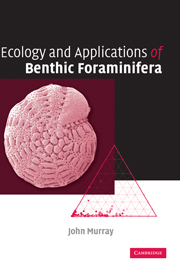Book contents
- Frontmatter
- Contents
- Preface
- 1 Introduction
- 2 Methods
- 3 Aspects of biology and basic ecology
- 4 Marginal marine environments
- 5 Shelf seas
- 6 Carbonate environments
- 7 Deep sea
- 8 Summary of living distributions
- 9 Taphonomic processes: formation of dead and fossil assemblages
- 10 Applications
- Glossary
- Appendix
- References
- Taxonomic Index
- General Index
3 - Aspects of biology and basic ecology
Published online by Cambridge University Press: 12 August 2009
- Frontmatter
- Contents
- Preface
- 1 Introduction
- 2 Methods
- 3 Aspects of biology and basic ecology
- 4 Marginal marine environments
- 5 Shelf seas
- 6 Carbonate environments
- 7 Deep sea
- 8 Summary of living distributions
- 9 Taphonomic processes: formation of dead and fossil assemblages
- 10 Applications
- Glossary
- Appendix
- References
- Taxonomic Index
- General Index
Summary
Introduction
The aim of this chapter is to set the scene for examining and interpreting ecological distribution patterns in the major environments. Therefore it is appropriate to discuss relevant aspects of biology and ecological concepts. For definitions of basic terms see the Glossary.
Biology
The presence of the test in foraminifera makes the group attractive to geologists because it provides a fossil record (Cambrian to Recent) but to biologists the test obscures most of the soft parts so relatively few studies have been carried out on foraminifera compared with naked protist groups. Nevertheless, important and interesting observations were made on their life activities, particularly from the late-nineteenth to mid-twentieth century, by a small group of people who had the patience to sit at the microscope and make observations for long periods (e.g., Lister, Schaudinn, Schultze, Heron-Allen, Jepps, Myers and Arnold). In recent decades there have been great advances in both observation and understanding due to improved technology (transmission and scanning electron microscopy, introduction of new fixation techniques, radiotracers, stable isotopes, cell physiology, microanalytical methods, etc.). However, although there is now a greater understanding of the way foraminiferal cells operate, there is still very little understanding of the physiological response to varying environmental conditions. That surely holds the key to understanding the niches of individual species and the interpretation of patterns of distribution and should be a major topic of research in the years ahead.
- Type
- Chapter
- Information
- Ecology and Applications of Benthic Foraminifera , pp. 27 - 60Publisher: Cambridge University PressPrint publication year: 2006



